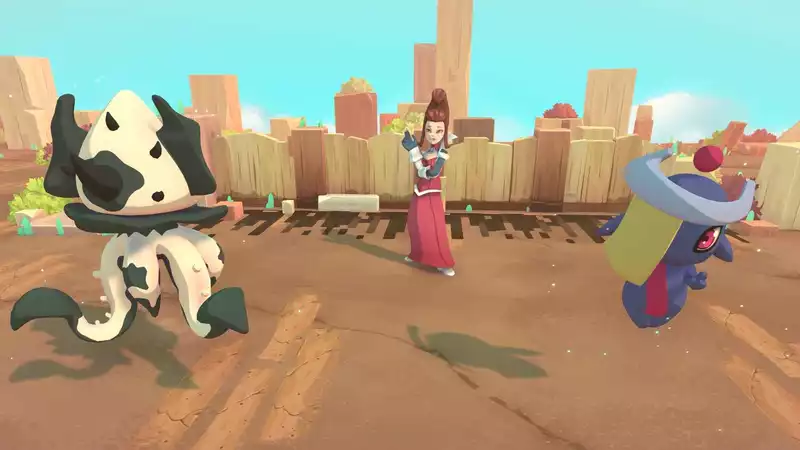Let's not beat around the long grass here: Temtem is a Pokémon clone by design. Crema, a small Spanish studio, set out to create something instantly familiar and accessible to fans of Nintendo's monster-collecting JRPG series, while leaving room for bold new ideas. The developers assume you're already familiar with Pikachu and Pigeon, so I will be too.
For starters, Temtem is an MMO. Sort of. While your interaction with other players is limited to chatting, emoting, and challenging battles, and you won't step on other players' toes while exploring, the overworld is a bustling place full of players and pets. Although intended for solo play, the entire story can be played cooperatively with friends, and there are many opportunities for group dungeon tours at the end of the game.
This makes the world of Temtem, consisting of islands floating around a magical pseudo-sun, a vibrant place. The trade-off for this perpetual shared world is monetization. In addition to fixed prices, there is premium currency that can be used for cosmetic goods and seasonal battle passes that distribute dress-up items over time. Fortunately, money does not buy success; it requires an investment of time and effort and learning a lot of damage type tables.
Temtem's biggest difference from Pokémon is its more complex combat, which falls somewhere between Pokémon's kid-friendly design and Shin Megami Tensei's hardcore dungeon exploration. battles with NPC tamers in Temtem are full 6-on-6 battles Often, both sides place two creatures at a time. Sharp AI and no skimping on enemy levels or stats make for a surprisingly challenging campaign. Those accustomed to playing Pokémon in their sleep may need to buck up and pay attention here.
Multiplayer battles (such as informal challenges in the overworld and ranked battles by level) are more complex; those familiar with DOTA's competitive rules will be familiar with this format. Players bring squads of eight Temtems to the table and take turns picking and placing five of them. It can be nerve-wracking until you get used to it, but thankfully, even single players can practice this practice by challenging a defeated dojo chief (the equivalent of a Pokémon gym leader) to a simulation match.
Temtem combat is more subtle than Pokémon. Temtem has both HP and a steadily recharging stamina pool, and attacks deplete the stamina pool. Low-level creatures are prone to overuse, as they are ravaged by just one major attack. Stamina debt is deducted from that tem tem's health and it will not be able to attack on its next turn. However, during this cooldown, actions such as tagging out or recovering with items are possible, making it a viable tactical option. The "hold technique" is also a powerful attack and can only be selected if Temtem does not continue fighting for several turns, further complicating matters.
What Temtem removes from Pokémon is also interesting. Aside from the chance of capture, there are no dice rolls during the battle. There are no critical hits, and status effects are always established. Everything is deterministic, but there are ways to cheat the numbers. All skills have speed multipliers, allowing slower creatures to quickly poke faster creatures with heavier attacks. Strategy plays an important role from the start, and while grinding to higher levels can be effective, playing smart is almost always better than brute force.
With complex combat, 2v2 battles, 12 different damage types (imagine playing rock-paper-scissors with 12 different options using both hands), and the ability to change your temtem's skill loadout outside of combat, Temtem is an almost overbearingly involved game It is. Having lost interest in Pokémon early on, that's exactly what I needed. Aside from the number of creatures (currently only 164), this is "Pokémon" on almost every mechanical level: it is Advanced Edition. Familiar, yet satisfyingly complex.
Objectively speaking, "Temtem" is a very well-tuned work of the genre. Subjectively, its aesthetics and worldview are not for me. It may not be to everyone's taste, but many of the creature designs are oddly generic, lacking the simple charm of a Pokémon or the wild imagination of a Digimon. Many of them are angular, stylized animals, and many of their names are also very unpalatable. I understand that "squirrel" and "punch" together make sense as a formidable fighting rodent, but "skunk" sounds more like a disease you'd rather not get.
Similarly, the game's human cast (and most of their dialogue), while occasionally gag funny, falls a bit short of Nintendo's punny charm. The villain (aristocratic Clan Belsotho) also falls short of Team Rocket. Player and NPC costumes and character customization options are extensive, but the basic character models feel more interchangeable than they should: the Temtem world sometimes has the same six people (children, teens/adults, elders male and female types), feel as though they are switching costumes more and more to fit their roles in their respective communities.
Still, while the art of the creatures and characters does not capture my imagination, it is a great game on a technical level. The creatures move well, and while I wish there was an option to fast-forward through battles, the big attacks are often satisfied with a barrage of polygons and particle effects. The game also feels more at home on PC than on consoles. Even though the multiplayer is completely cross-platform, I felt most comfortable with mouse and keyboard control.
While I would have appreciated some more in-game reference material (such as hotkeys to display a dizzying matrix of damage types), Temtem puts most of the important information in front of you. If you want to be the best, you need to learn them all. Although it falls a little short in terms of appeal, and the battle path feels a little out of place, Temtem is easy to recommend to Pokémon fans who want something a little tougher and meatier, while still feeling familiar."
.

Comments